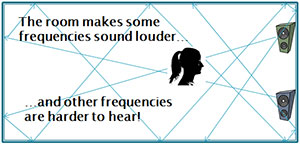From IK Multimedia, the makers of such cool home recording products (we reviewed the iRig Mic recently here: https://www.homebrewaudio.com/pqo) as the iRig Mic and the iKlip (mic and iPad stand for iPhone, iPad and iPod Touch) have just announced the iKlip MINI. See below for details.
IK Multimedia introduces iKlip™ MINI
The universal microphone stand adapter for iPhone® and iPod touch®

iKlip MINI is made of sturdy, durable thermoplastic and is compatible with every existing iPhone and iPod touch, from the original models to the latest generation devices. iKlip MINI firmly holds the device in place in both horizontal and vertical positions, and its multi-angle adjustable design allows for optimal viewing and accessibility to all controls, buttons, connection ports and camera free from obstruction. It can also be easily rotated from portrait to landscape position by simply loosening or tightening a knob with no need for additional tools. It can be mounted on the vertical pole of a mic stand as well as on its horizontal boom.

Users of another popular IK Multimedia mobile device accessory, iRig, can use their guitar interface adapter with the iKlip MINI with the included detachable bracket support. This makes iKlip MINI the perfect accessory for the AmpliTube range of apps or any other guitar effects app.

Other apps for iPhone/iPod touch can also benefit from the iKlip MINI’s support for floor or tabletop mic stands including karaoke, score and tablature, DJ, recording, mixing, video, photography, teleprompting and many more.
For more info: iKlip MINI
Archives for July 2011
Hay Bale Studio At Bonnaroo 2011
Interesting piece on “field” recording (literally!) – In June 2011, a unique studio sprang up at the Bonnaroo Music and Arts festival – the “Hay Bale Studio”. Aptly named after the dozens of hay bales positioned on the exterior for sound rejection, the space allowed more than 35 of the festival’s acts to record tracks in a purpose-built recording studio. Tracks from artists such as Ray LaMontagne, Amos Lee, Iron and Wine, Mumford and Sons, and The Decemberists were transferred to the radio tent next door and broadcast on radio stations nationwide. Approximately 45 radio stations nationwide featured these “Bonnaroo sessions” over the weekend.
Read the full article here:
Guitar Center Professional Again Helps Outfit “Hay Bale Studio” At Bonnaroo 2011
Best "Home Recording Answer" on Yahoo! Answers
HBA Yields “Best Home Recording Answer” on Yahoo! Answers – that’s what we like to see!
Here is what appeared (again:)) today on Yahoo! Answers regarding home recording questions:
Resolved Question
Should I use USB or Line-in For Vocal Recording?
Best Answer – Chosen by Asker
Recording Notes: Check Your Mixes EVERYWHERE
Excellent home recording advice in an article on ProSoundWeb – a really important message, especially for the folks recording and mixing music.
As I have said in the past, if you are recording and mixing at home in a spare bedroom (and who isn’t if you’re doing “home recording?), and you don’t have your room treated (acoustic absorption panels, etc.) to give you as close to a true listening set-up as possible (this is NOT the same as sound-proofing, and you REALLY have to know what you’re doing), then if you ONLY mix in that room, you’re audio will not be as good as it could be. (note: if you have no idea what I’m talking about here see our article: What is Equalization, Usually Called EQ?
See full PSW article here: http://www.prosoundweb.com/article/recording_notes_check_your_mixes_everywhere/
Your Ears Are Lying to You – Why Your Song Sounds Great in Your Room, But Not in Your Car
 I’ll bet you didn’t know that your ears are lying to you. Oh yes. They only let us hear a small range of sound, the stuff between 20 and 20-thousand cycles per second (or “hertz”..a kilohertz is a 1000 of those cycles, usually abbreviated “KHz”). So there are lots of sounds out there you can’t hear…right now. They could be wonderful, but you’ll never know, thanks to your lying ears.
I’ll bet you didn’t know that your ears are lying to you. Oh yes. They only let us hear a small range of sound, the stuff between 20 and 20-thousand cycles per second (or “hertz”..a kilohertz is a 1000 of those cycles, usually abbreviated “KHz”). So there are lots of sounds out there you can’t hear…right now. They could be wonderful, but you’ll never know, thanks to your lying ears.Why should you care? Well, if you’re a musician, or voice actor, a recording engineer, or just recording audio for podcasts and videos, this knowledge is crucial. Here’s why.
Our ears still lie to us EVEN when the sound IS in that 20-20KHz range, the bastards. Some sounds seem louder to us than others even when they are at the same volume, like a baby’s cry (around 3 KHz – this will really blow your mind – or maybe you’ll just find it boring). Rooms, those big boxy things we normally spend a lot of time in, change how a sound….well….sounds. If sound were like light, your typical bedroom would be kinda like a house of mirrors; but you wouldn’t be able to SEE the mirrors! Put a little candle in just the right place in that room, and it gets reflected by so many mirrors that is seems like a search light. But if you move that same candle to a different spot, you might not be able to see it at all. You also should know that just about every room in the world has a different mirror set-up.
Now imagine that someone asked you use that first room to create a very specific color and intensity of light bulb. Maybe they want it for something kinky, I don’t know. But their specs say it needs to be “a soft red, and very subdued.” Now remember that we can’t see the mirrors. We set to work adjusting the controls on our bulb-maker until we get one that puts out a nice, soft red light with just the right amount of “subdued.” You confidently take your light to the client, who puts it into a socket in his room, and suddenly it’s really bright, and now a kind of fire-engine red! What happened to the bulb? It looked great in your room. Nothing happened to the bulb. It is as it was when you made it. But the mirrors in the client’s room (the ones you can’t see) are different from the ones in yours, and they cause the light to be reflected differently, making it APPEAR different. Which one is right? Neither! Hah, you’re starting to get angry at me now, aren’t you? But it’s true, and it’s just like audio. Until you can find a room with no mirrors, or at least with the biggest ones removed or shifted to eliminate the worst of the reflection problems, you literally CAN’T know what the bulb’s light really looks like.
How does this translate to audio?
 Well, if my room tends to amplify bass frequencies, my ears would tell me that there was too much bass in a song when there really wasn’t! So I might respond by turning the bass down on the equalizer (EQ) too much before I burn the song to CD. In that room, it sounds fine because the bass is being artificially boosted by the room itself. But as soon as I take it my buddy’s room, which is larger, or my car (which in the case of home recording may ALSO be larger:)), I might find there is no bass left at all in the recording!
Well, if my room tends to amplify bass frequencies, my ears would tell me that there was too much bass in a song when there really wasn’t! So I might respond by turning the bass down on the equalizer (EQ) too much before I burn the song to CD. In that room, it sounds fine because the bass is being artificially boosted by the room itself. But as soon as I take it my buddy’s room, which is larger, or my car (which in the case of home recording may ALSO be larger:)), I might find there is no bass left at all in the recording!
The only real way to deal with all of this ear-lying nonsense is to know a little something about HOW they lie, which means you gotta get familiar with EQ and all that stuff about Hertz and crying babies. That way, you’ll at least know how to get a much more accurate picture of the truth, and your sound will sound good in ALL rooms, not just yours. If you are of a mind to dive deeper into the world of EQ and frequencies, a great place to start would be our article What is Equalization, Usually Called EQ?